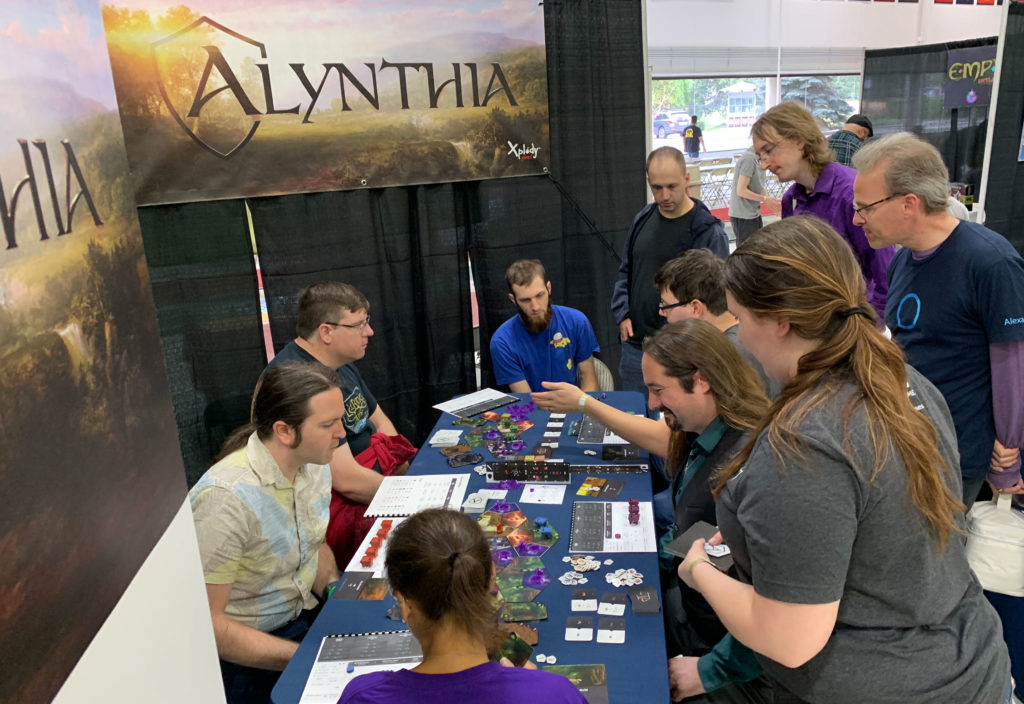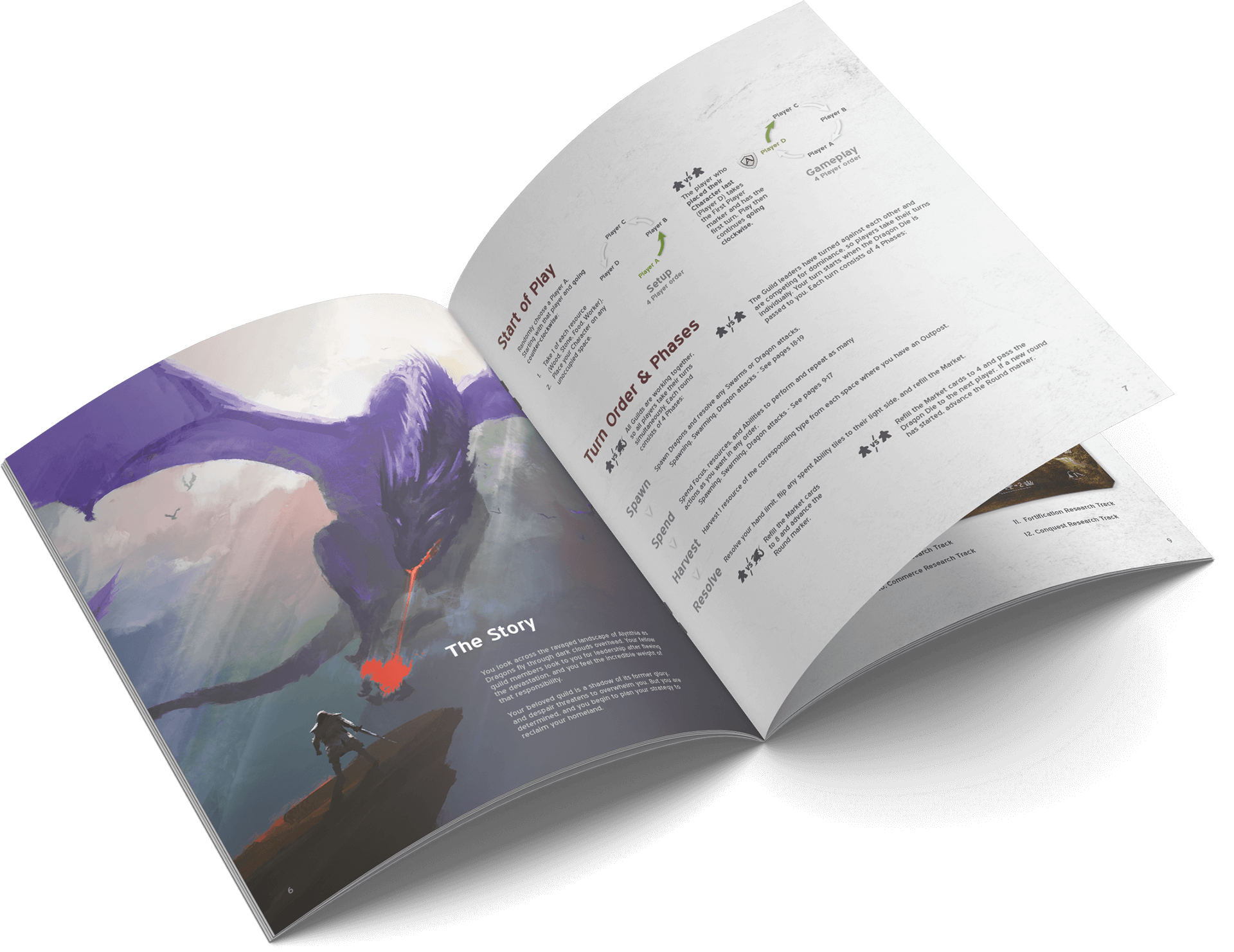Have some fun.
Building a tabletop game brand
Overview
To a ‘non-gamer’, board games might conjure thoughts of Monopoly®, Scrabble®, Risk®, or Catan®. But to a full-fledged tabletop gamer, that’s not even scratching the surface. I created a unique board game, built a company, and developed multiple products for it.
Challenge
Board games have blossomed over the last few decades into a massive industry of devoted users, with too many sub-genres to count. Market penetration is difficult, and most board games never see the light of day. That’s the world I entered when I decided to create my own board game, build a company around it, and grow a following of excited gamers.
My role
Cofounder
- Brand design
- UX/UI design
- Web design
- Web development
- Print Design
- Vendor Management
Research
The current state of board games.
Despite literally thousands of board games to choose from, consumers want more. Independent games have seen great success under the right conditions.
Gamers are willing to spend money on their hobby
According to a 2017 survey, gamers spent significant amounts on board games every year.
- 15% spent $100-$199
- 35% spent $200-599
- 43% of gamers spent $600 or more on tabletop games
There are a lot of factors that impact a game’s price, but it’s clear that the average boardgamer is willing to spend on games of interest.
Gamers are willing to back indie games.
Kickstarter has seen pledges totaling more than $778 million for game projects.
57% of gamers have backed crowdfunded games.
Gamers want variety, quality, and quantity.
In the past year, the majority of gamers (41%) purchased five to ten new games or expansions. Just under a quarter (24%) purchased 11 or more, with 27% of that group having purchased more than 30! (source: PrintNinja)
Define
Target Audiences.
Primary Target
- Single men aged 25-45 (primarily millennials)
- US residents
- Other games they may enjoy: Catan®, Pandemic®, Scythe®, Kemet®, Terra Mystica®
- Usually play games with same small group of people
- Value strategic thinking and direct competition, or teamwork (or both!)
- Enjoy medium-weight games and mechanics involving luck/combat dice rolling, area control, resource management, and card-drafting
- Don’t mind putting in the effort to master a game with a somewhat steep learning curve
- Middle class or higher: Average yearly income of $50k or more
- Early adopters
- Relatively active on Kickstarter (back 4+ projects per year)
- Prefer indoor activities to sports/outdoor activities
- Experienced gamer
- Purchase 5+ new games per year
Secondary Target
- Male or female
- Married with smaller families (1-2 kids if any)
- If they do have kids, they are most likely older (35+) with teenage kids
- Affluent ($60,000+)
- More casual gamers
- Experience mostly comes from mainstream games (like Catan)
- Purchase ~3 new games per year
Personas.
Boardgamer personas are quite varied, but I did my best to narrow them down to a targeted few.
The Group Gamer
The Group Gamer is typically a Millennial or Gen-Z and part of a close group of friends with a weekly board game night. They enjoy a large variety of games, but tend not to play as many solo games. They enjoy cooperative games where the game itself is what they’re competing against. This group is most likely to have couples in it, but singles are welcome as well. They may feel at home with ‘casual nerd culture’ or ‘geek chic’. They probably have a so-called ‘shelf of shame’ – games they’ve purchased but haven’t played yet.
The Collector
The Collector is more about owning games than playing them. They look for the new and different and have a large collection of games, usually surpassing 80+. They’re at home on Kickstarter, backing multiple projects each month, with a steady stream of new games arriving at their doorstep. They get excited about unique game components and value quality materials, like double-layered chipboard, wood and metal pieces, and complex resin/plastic sculpts.
The Adventurer
The Adventurer is all about the gaming experience. Beautiful design is as important as the gameplay, but not quite enough to push to purchase if the gameplay itself looks sub-par. They’re most likely to read the rulebook and supporting materials thoroughly, including any world-building or backstory ‘flavor’. They also value quality components, but not at the cost of an enjoyable gameplay.
The Elite
They barely need a description. The Elite takes aspects from all of the above personas and more. They have a large collection of games, know their components, rules, and strategies inside and out, and are willing to debate at-length any discrepancy they find. They’re very competitive, but above all, they love games.
Ideate/Test
The Company.
Xplody Games
Let’s have some fun.
Knowing the target audience I was pursuing, I aimed for a company logo and brand that hit near the middle of the pack.
For the Group Gamer and the Adventurer, I went with a modified version of a quirky font that eschews straight lines. Off-axis letters, bulbous tips, and a swirling interplay between the ‘p’ and ‘d’ create an organic, friendly feel. To top off the ‘fun’ aspects, the name itself is all but formal, and I created a mascot to fit the name and aesthetic out of the ‘o’.
For the Collector and the Elite, I chose bold, distinctive colors that would stand out on the game box, and on the shelf. The name also lends itself to these groups; Explosions evoke energy and action – emotions I conveyed to tie into the group’s passion for gaming.
Next came the website…
The front page wireframe actually hit pretty close to the final mockup/design. The biggest change was removing the social icons from the top header. They turned out to be too prominent when they were only a tertiary call to action.
The blog page, however, went through several iterations before I went forward with the build.
This progression was based on different factors at each stage.
At first, the concept was to highlight the most recent blog post. Two major issues arose with this: First, the blog, while very important for establishing credibility and a decent SEO score, was never intended to be updated regularly enough for a featured post. Second, it was busy. The visual hierarchy needed work.
The next concept solved both of the previous problems, but created a new one. It was boring. For a company that was all about having fun, it was a grid. There wasn’t anything visually interesting about it.
The last concept brought back the fun aesthetic while still avoiding the logistical pitfalls from the first version. It broke the norm by pushing the featured image from each post out of the containing box. It kept to the brand aesthetic with heavily rounded corners. Tags added in at the top also meant the blog could better serve its purpose to establish credibility – easy to learn more about each subject.
Or so I thought.
It turns out I grossly underestimated readers’ specific interests. Depending on the reader, they might be reading for updates about a specific game. Or they wanted tips on how to make their own games. Or they were following the company, just along for the ride.
This led to the creation of a sidebar filter and blog search field which did a great job of solving the problem. Users can choose their path with a single click.
Alynthia
The boardgame that started it all.
Developing a board game can be more involved than creating a brand – because that’s exactly what you’re doing on top of actually making a fun, playable game.
A retail or SaaS company might have their product branded exactly the same as their business. But for a board game, you need to create a world for the user to immerse themselves in. This thematic branding carries through across everything – the game, its marketing, its web page.
Game Branding
I just finished telling you all about research and personas that went into creating Xplody Games. I continued that research looking at Alynthia and its peers. What games was it like? How did it differ? These led to a lot of important decisions about the game’s complexity and style.
“I just like it because it has dragons.”
You’d be surprised how often I’ve heard that. If that’s the hook that pulls them in, I’m all for it. But for some reason, it took a long time to make the connection that the game’s art didn’t reflect that!

Booth branding? No dragons.

Game about fighting dragons? No dragons on the box.
Web page branding? Still not much in the way of dragons.
The process of switching over from non-dragon branding to the fire-breathing monsters we all know and love is ongoing, but the results so far have been very promising. Sometimes it just takes stepping back and then leaning into the areas that are working to make a big impact.

The new rulebook is very dragon-y.
The new box art shows the theme and goal of the game much more clearly.
Game UI
One of the most interesting aspects of boardgame creation (to me, at least) is the development of what I call ‘analog user interfaces’. The gaming industry calls them player boards. They’re the chipboard that goes in front of you and tells you what you can do, how you can do it, and how to keep track of it. And there’s a lot that goes into this.
When working with a physical medium, you have very limited space. Information density is highly important – but you can’t sacrifice the experience. Branding, clarity, and intuition are vital to an enjoyable game.
I developed a case study that centers completely around just one player board. There’s easily that much to think through! Want to hear about it? get in touch
Results
An award-winning game with a growing fanbase.
Best Hobby Game – to be clear, that means this game beat out hundreds of submissions and another 50 or so in-person at the convention showcase – to win the category set for the hobbyists. You might know them as ‘The Elite’ from earlier. Paid judges with expert knowledge in the industry have affirmed I hit the target market I wanted to, and did it well.
But to me, the real results are always going back to what the users ahem, players had to say about it. So I’ll leave you with a handful of recent quotes from people who have recently played Alynthia at various conventions it’s been shown at.
“I love this game. Very impressive. Very sharp.”
“Fantastic game!”
“I want to get this.”
“I can’t wait for this to come out!”
“When are you guys going to publish this?”
“It looks really cool. It looks elegant.”
“It’s a ton of fun, but still challenging.”
“I love a game like Alynthia where you walk away and ask what if I did Y on turn X. This leads to really wanting to come back to the table and try other strategies.”
“Where can I sign up to get updates?”
“My gaming group would have so much fun with this.”